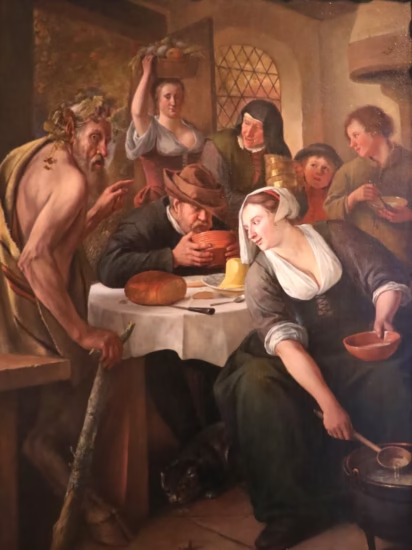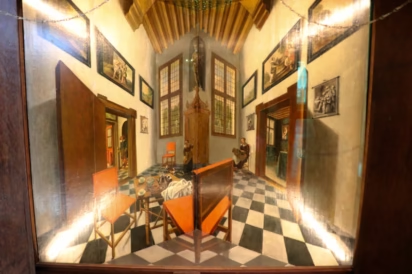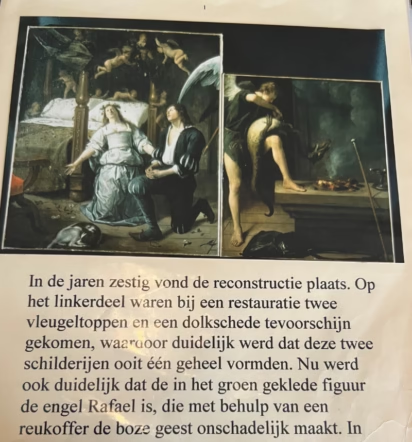Visit the wonderful Bredius Museum in The Hague to see fine art in a typical wealthy art connoisseur’s house near the Mauritshuis in Den Haag.

The Museum Bredius in Den Haag displays the private art collection of Abraham Bredius, a very wealthy art historian and director of the Mauritshuis in the early twentieth century. His collection of Golden Age paintings included works by Rembrandt and Jan Steen but also rare paintings by lesser-known artists.
See Dutch Golden Age Art in the Museum Bredius in Den Haag
The current Museum Bredius is in a beautifully restored 18th-century house in the heart of The Hague. The exhibition’s core is the private art collection of Abraham Bredius (1855-1946), often considered the first Dutch art historian. The collection includes paintings (over 200), drawings, furniture, silver, and porcelain.
The small museum is a joy to visit. Visitors are invited to sit down on the furniture and to page through the books and catalogues as if visiting a normal residence.
The Museum Bredius is very close to the Mauritshuis with one of the world’s best collections of Dutch Golden Age paintings and the popular Escher in the Palace Museum.
Dr Abraham Bredius
Dr Abraham Bredius (1855-1946) is generally considered the first art historian of the Netherlands. He came from a very wealthy family, which allowed him to explore his love of art and acquire an extensive collection. His deep knowledge, especially of Rembrandt, Jan Steen, and Johannes Vermeer, often allowed him to acquire unknown or unidentified works at very good prices.
Bredius was the director of the Mauritshuis for two decades during which period he assured the acquisition of over a hundred paintings including the two emblematic works of this famous gallery: Vermeer’s The Girl with the Pearl Earring (Meisje met de parel) and The Goldfinch (Het Putterje) by Fabricius. He also published the first comprehensive catalog of all 630 known paintings by Rembrandt in 1935.
Bredius lent (and later donated) many of his most important paintings to museums. The Maurtishuis received 25, including The Moors by Rembrandt, and the Rijksmuseum 43. Others were sold during his lifetime including his own Vermeer — The Allegory of Faith — which he described as “a large but unpleasant Vermeer”. (Now in the Metropolitan Museum of Art in New York.)
Dutch Golden Age Paintings in the Museum Bredius

Abraham Bredium made his own private collection of over 200 paintings already accessible to the public in the 1920s when he moved to Monaco for health reasons but thought the Mediterranean climate would not be healthy for the paintings. This collection of paintings, drawings, silver, furniture, and porcelain was left to the city of Den Haag and formed the basis of the Museum Bredius, which moved from his original house to its current location in the late 1980s.
Not all the donated works are on permanent display but almost any may be inspected upon request. The museum has no ambition to expand the collection, but small temporary exhibitions may see a few special works on display to complement the choice of Bredius.
Bredius was particularly fond of the Dutch Golden Age painters such as Rembrandt, Frans Hals, Johannes Vermeer, and Jan Steen. His best paintings went to major museums but he enjoyed keeping interesting works at home.
Several of these paintings are of art historical importance or curiosity rather than pure artistic merit. He thus owned a rare group portrait by peasant-genre painter Adriaen van Ostade and a Bacchus orgy by landscape artist Philips Koninck.
Bredius also enjoyed collecting high-quality paintings by lesser-known painters such as Tavern Scene by Willem Buytewech and Portrait of a Woman by Willem Drost.
More Art in the Bredius Museum

Wealthy Dutch families enjoyed owning and displaying porcelain, crystal, and silverware since at least the 17th century and these remained popular at the start of the 20th century. Bredius left a large collection of porcelain from the 17th to 19th century with many items from China, Japan, and Germany. Many of these are displayed in the museum on the mantelpieces and tables as they would have been shown in a normal residence.
The Perspective Box, c. 1680, by Samuel van Hoogstraten is a painting in a box that is only realistic when viewed from a particular position. This was used to show off skills and advertise when selling paintings to courts in Europe. This is one of only six in the world and the only one in the Netherlands. In a similar vein is an anamorphic portrait of King Charles I (anonymous, 17th century) that only reveals the head of the executed king if the painting is viewed in a curved mirror.
Bredius also owned many drawings including numerous works by famous artists such as Rembrandt, Rubens, Ruysdael, Hals, and Van Gooyen. Many are displayed or could be shown on request.
Bredius and Rembrandt


Abraham Bredius was a Rembrandt specialist. He not only secured the purchase of important Rembrandt paintings by the Mauritshuis but owned several himself. Two small Rembrandt paintings and several drawings by Rembrandt are in the Museum Bredius.
Rembrandt’s Christus en buste (Bust of Christ) was probably painted in preparation for his Road to Emmaus paintings (now in the Louvre and SMK Copenhagen). Rembrandt was probably the first European artist to have used a Jewish model for a portrait of Christ. Bredius acquired the work in 1911. More recently, some questioned whether the work is entirely by Rembrandt.
Bredius obtained a small painting Kruisoprichting (Raising of the Cross, 1642-45) in 1921. He was convinced it was by Rembrandt and assumed it was made in preparation for a Passion Cycle (now in the Alte Pinakothek in Munich). Later art historians downgraded the work to a “crude imitation” in 1969 or “an important later copy” in 1973.
However, more recent research confirmed Bredius’ opinion. The technique and the science support Rembrandt but Bredius got the period wrong — it was only painted a few years after the Munich cycle.
Tobias and Sarah by Jan Steen

Probably the best-known painting in the Museum Bredius is Tobias and Sarah in Prayer with the Angel Raphael and the Demon (or The Wedding Night of Tobias and Sarah / De Huwelijksnacht van Tobias en Sarah, circa 1668) by Jan Steen. Of the six Steens in the museum, Bredius owned the smallest part of this one.
Bredius acquired a smallish painting of an angel with a dragon in 1907. Decades later, only after a much larger Tobias and Sarah painting was restored, was it realized that the two paintings belong together. (The angel’s wing in the larger painting was long painted over.) In 1996, the two pieces were rejoined.
However, the larger section was owned by a Jewish refugee Jacques Goudstikker. His part was only restituted after the work was rejoined. As the Bredius testament made no provision for any works being sold, the city of Den Haag eventually had to buy out the whole painting.
Story of Tobias and Sarah
The story of the wedding night of Tobias and Sarah is interesting too and its depiction is not rare in art. It is from the Biblical Book of Tobit (apocryphal in the Protestant tradition).
A demon fell in love with Sarah and killed six of her husbands in succession on her wedding nights. Tobias insisted on marrying her anyway. So on her seventh wedding night, her parents already dug a grave during the night to hide the evidence in the morning. However, Tobias’ traveling companion, the archangel Raphael in human disguise, drove out the demon (to the deserts of Egypt!) by burning the liver and heart of a fish they had caught earlier in the Tigris. The happy couple survived the night and had a happy and blessed life.
The earlier catching of the fish is shown in the museum in the painting Tobias and the Angel (1630-32) by Matthias Stom. Tobias and Raphael appear twice: in the background catching the fish and in the foreground burning the fish but keeping the liver, heart, and gall bladder that were later used for cures.
Bredius Museum Visitor Information

Opening Hours and Tickets for the Bredius Museum
The Bredius Museum is open Tuesday to Sunday from 11:00 to 17:00.
Ticket prices are €8.50 for adults, €4.50 for students, and free for children under 18 years old.
Tickets are available online but add a surcharge and such time-slot reservations are unlikely to be needed on most days, in contrast to the nearby Mauritshuis where first one in is the most pleasant.
Admission is free for bearers of the Dutch Museumkaart or the Rembrandtpas.
Many explanations in the museum and even the website are in Dutch only. However, the individual paintings are at least identified in English while comprehensive English notes and catalogues are available in most rooms.
Transportation to the Bredius Museum in The Hague
The Museum Bredius, Lange Vijverberg 14, 2513 AC Den Haag, Nederland is beautifully located across the pond (Hofvijver) from the Mauritshuis and the Dutch parliament complex.
The closest tramstops are Buitenhof and Kneuterdijk but for many visitors, it is an easy stroll from other sights in central Den Haag. Walking from the Centraal main station would take around 15 minutes. From the Kunstmuseum use tram 17 or buses 28 or 24.
More in Den Haag / The Hague
- Mauritshuis — a top collection of Dutch Golden Age Old Masters’ paintings.
- Museum Bredius — the private art collection of a former Mauritshuis director.
- Kunstmuseum Den Haag — modern art including the largest Mondrian collection in the world.
- Louwman Museum — one of the best car museums in the world with the largest collection of veteran cars (up to 1904) in the world.


